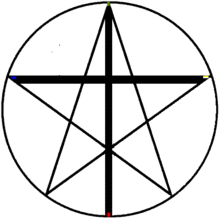Christianity and Neopaganism
Christianity and Neopaganism overlap when the beliefs or practices of one religious path influence, or are adopted by, the other. Historically, Christianity sometimes took advantage of traditional pagan beliefs when it spread to new areas – a process known as inculturation. Thus newly established churches took on sites, practices or images belonging to indigenous belief systems as a way of making the new faith more acceptable.[1][2]
More recently, in a parallel process, some followers of modern pagan paths have developed practices such as Christopaganism by blending Christian elements into Neopagan practice.[3]
Historical syncretism
Christianity and classical Paganism had an uneasy relationship with each being at different times persecutor or persecuted.[4] However each also influenced the other. For example, a 10th–11th-century manuscript in the British Library known as the Lacnunga[5] describes a charm against poison said to have been invented by Christ while on the cross, which has parallels in Anglo-Saxon magic.
Modern syncretism
In the modern era, examples of syncretism may include Christians seeking to incorporate concepts of the Divine Feminine from Neopaganism into Christianity[6] or Neopagans seeking to incorporate figures such as Jesus or Mary into Wiccan worship.[7]
Christopaganism
The use of this term to refer to a modern Christian neopagan synthesis can be confusing, since the word "Christopaganism" is already in use in academic circles to describe historical accommodations to Christianity by indigenous peoples (often incorporating elements of their past religions — see folk Christianity, folk Catholicism).
Joyce and River Higginbotham define Christopaganism as: "A spirituality that combines beliefs and practices of Christianity with beliefs and practices of Paganism, or that observes them in parallel."[8] They give examples of people identifying as Pagan but observing both Pagan and Christian liturgical years, using the Rosary or observing a form of Communion.
Christian Wicca

Christian Wicca is a term coined in reference to Trinitarian Wicca, established in 1999. Since then, Christian Wicca has become the umbrella term for a variety of magickal Christian sects that began evolving in the Christopagan movement.
Trinitarian Wicca is based on the merging of Alexandrian and Dianic traditions, forming their pantheon from the Kabballah, Gnosticism, and Ancient Christianity. Working within traditional Wiccan ritual structure, they observe the 8 sabbats, 13 esbats, and the Wiccan Rede without any concern for the dogmatic trappings of patriarchal Christianity. They have a devout reclaiming approach to a Goddess-inclusive Trinity, best described as Tritheist or Social Trinitarians.
The term Christian merely reflects the pantheon best associated with the Trinitarian tradition, comparable to the term Celtic among Celtic Wiccan traditions. Despite the initial confusion, Trinitarian Wiccans consider themselves Wiccans not Christians, as their views of Christology was deemed heresy by the Catholic Church in the 3rd century CE. Trinitarian Wicca is not a blended path; they are a MesoPagan polytheistic reconstructionist tradition.[9][10]
Objections to syncretism
The most common Christian objections to Neopagan syncretism are the direct objections to witchcraft found in the Old Testament, particularly in Exodus, Leviticus, and Deuteronomy. Contemporary Christians may object to Neopagan beliefs in reincarnation, Neopagan rejection of the existence of the Devil, or to their polytheism.[11]
Neopagans may object to this syncretism for some of the same reasons as Christians. Other reasons cited include a Neopagan rejection of the doctrine of Original sin, an objection to evangelizing and a rejection of at least some of the Ten Commandments.[12]
See also
References
- ↑ Madsen, William. Christo-Paganism: A Study of Mexican Religious Syncretism (1957). New Orleans: Tulane University.
- ↑ Yamamori,Tetsunao. Christopaganism or Indigenous Christianity (1975). William Carey Library Publishers
- ↑ St Clair, Adelina. The Path of a Christian Witch (2010). Woodbury MN: Llewellyn Publications. ISBN 978-0-7387-2641-0
- ↑ Fox, Robin Lane. Pagans and Christians: In the Mediterranean World from the Second Century AD to the Conversion of Constantine (London: Viking, 1986, ISBN 978-0-670-80848-9; Penguin Books Ltd new edition, 2006, ISBN 978-0-14-102295-6)
- ↑ Pettit, Edward (ed). Anglo-Saxon Remedies, Charms, and Prayers from British Library MS Harley 585. The Lacnunga, (2001). Mellen Critical Editions and Translations, 6. Lewiston: E. Mellen Press, I: Introduction, Text, Translation, and Appendices, pp. 133–49.
- ↑ McColman, Carl. Embracing Jesus and the Goddess: A Radical Call for Spiritual Sanity (2001). Gloucester, MA: Fair Winds Press
- ↑ Pittman, Nancy Chandler (2003) Christian Wicca: The Trinitarian Tradition 1st Books Library, ISBN 1-4107-5347-6
- ↑ Higginbotham, Joyce & River. ChristoPaganism: An Inclusive Path (2009), Woodbury MN: Llewellyn Publications. ISBN 978-0-7387-1467-7
- ↑ Trinitarian Wicca – the name game, retrieved 2012-12-5
- ↑ , retrieved 2012-12-5
- ↑ Spotlight Ministries website. Christian Wicca? The Ultimate Oxymoron. Available at: http://www.spotlightministries.org.uk/christianwicca.htm Consulted 23 November 2010
- ↑ Wicca for the Rest of Us website. The Problem with Christian Wicca. Available at: http://wicca.timerift.net/christianwicca.shtml Consulted 23 November 2010
- Pearson, Joanne (2007) Wicca and the Christian Heritage, Routledge.
- Winston, Kimberly. Retooling Rosaries For Pagan Rituals; Former Catholics Find A New Spirituality In Prayer Beads (5 May 2007). The Washington Post. http://www.highbeam.com/doc/1P2-5890287.html
- Chandler, Nancy (2016) Trinitarian Wicca Homepage
